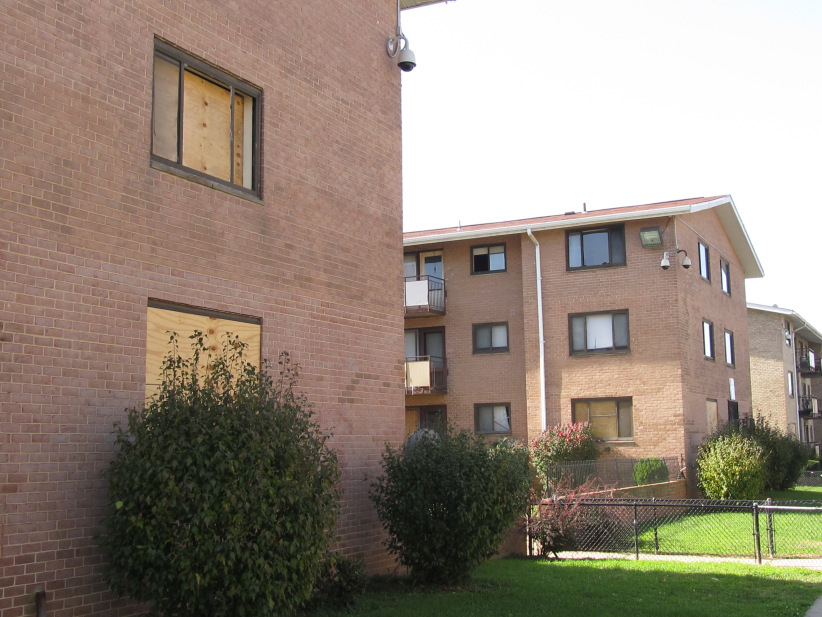Reposted with permission from ParkViewDC.com:
A lot has happened since the beginning of the year related to redeveloping Park Morton. Some of it is positive, some of it is disappointing, and much of it is causing confusion and angst throughout the community. As the overall redevelopment of Park Morton is complex, split over two sites, and is a mix of local and federal jurisdictions this post will attempt to provide an overview of where things stand and next steps.
The Bruce-Monroe Site
The development for the Bruce-Monroe Site as approved by the Zoning Commission.
As many may remember, the temporary park space that was once the site of the Bruce-Monroe Elementary School located on Georgia Avenue between Irving Street and Columbia Road was selected as the original “Build-First” site for the Park Morton redevelopment.
The Bruce Monroe portion of the project is particularly significant because it would provide 273 affordable units, including 189 in an apartment building, 76 in a senior building, and eight townhomes. Of the 273 units, 90 would be replacement apartments for Park Morton residents. The remaining 109 units would be affordable at 60 percent of the median family income, while 70 would be market-rate. The site would also create a permanent 1-acre park along Columbia Road.
The planned buildings for the Bruce-Monroe site required zoning relief for greater density and were part of a Planned Unit Development (PUD). One reason many supported the PUD was that the larger building made it possible to create the park. As the property is District of Columbia property, far less zoning relief – if any – would have been needed if the entire site were developed for housing and included no public green space.
Despite opposition from residents surrounding the Bruce-Monroe site, the Planned Unit Development and Park Morton redevelopment was supported by local neighborhood associations, Advisory Neighborhood Commissions 1A and 1B, the Park Morton Resident Council, the Council of the District of Columbia, and ultimately it was approved by the Zoning Commission in March 2017.
To prevent the project from moving forward, three (originally four) neighbors challenged the Bruce-Monroe zoning order in court on May 30, 2017, arguing that the planned buildings were too large and that the Zoning Commission inappropriately interpreted many of the District’s land use documents in approving the projects.
The case was argued on February 14, 2019 and the judges finally decided the case on June 25, 2020, with the result being that the Court vacated the zoning order and remanded the case back to the Zoning Commission for reconsideration.
While the Court of Appeals dismissed all of the petitioners’ concerns, the Court was troubled by the degree to which the Zoning Commission’s order used the language in the documents submitted by the development team and defined seven areas that it wants the Zoning Commission to review and respond to.
The Zoning Commission is currently reviewing the remand and no date has currently been set for when the Commission will publicly deliberate and outline their next steps in the process.
In short, both the appeals and the remand have significantly delayed this phase of the original plan, resulting in the original Phase 2 of the redevelopment to now be the first phase of development.
Based on information shared at the January 23, 2020, Park Morton Steering Committee Meeting, the plan to redevelop Park Morton has being adjusted to allow redevelopment to move forward while the Bruce-Monroe development effort is sorted out.
The most significant change from the original development plan is that the original Phase 2 of the development plan has become the Phase 1 of the plan (see the area outlined in orange below).

This area is the location of the planned larger apartment building on Park Road which would replace two currently empty Park Morton buildings on Park Road and other buildings which are still occupied. The construction timeline for this area is currently scheduled for the beginning of 2021 with completion by the end of 2022 or early 2023.
In order for construction to begin, housing needs to be coordinated for several Park Morton residents who live in impacted buildings and the DC Housing Authority has begun offering housing vouchers and is relocating residents who chose to move off-site. However, there is also an option for residents to move to vacant apartments at Park Morton in buildings that would not be affected by this construction. Based on a recent conversation with the DC Housing Authority, there are currently 17 empty apartments at Park Morton in buildings that would not be impacted by the Park Road development.
The changes to the phasing of the Park Morton development does not alter the overall plan and will not have an impact on the number of housing units produced. The development still plans to replace the remaining 147 units at Park Morton with 545 mixed-income units. Park Morton residents have a guaranteed right to return to the Park Morton and Bruce-Monroe sites in a new replacement apartment. There are also plans being reviewed to make home-ownership opportunities available for Park Morton residents – though the exact number has not yet been determined.
The Park Morton Equity Plan
With the delays caused by the Court challenge to the Bruce-Monroe site and the disruption and displacement caused by refocusing the start of development to the Park Morton footprint, there is little wonder that Park Morton Resident Council President Shonta High and other neighbors have rolled up their sleeves to find a solution. The outcome of their effort is called the Park Morton Equity Plan (PMEP).
According to information shared with ANC1A, Ms. High’s PMEP Objectives include:
- Equity At Least 15% Home ownership;
- Full Rights For ALL Residents To Return;
- Larger Unit Sizes to Accommodate Families;
- Build First;
- A Clear, Concise Resident Led Relocation Plan;
- Residents Need To Remain In Ward 1 (Look at other buildings like The Wren);
- LDA Negotiation To Include Park Morton Residents As Partners With A 30% Share In The Redevelopment (TOPA like rights ratified in an agreement);
- Create 133+ New Permanent Career Opportunities;
- Affordable Units Must Remain Affordable During the Life of The Project;
- The Return of 174 Low-Income – Affordable Units at The Park Morton Footprint;
- No Loss of Amenities;
- Redevelopment Must Be Consistent With The City’s Comprehensive Plan;
- Ensure That Any Relocation Plan Does Not Adversely Effect Park Morton Residents
Many neighbors and community leaders are in agreement that the aspirational goals of this plan are worthy of consideration in city-wide developments moving forward, and where possible need to be included in the Park Morton efforts as well. However, some of the details of the PMEP as presented are likely not achievable at Park Morton due to the late stage of the planning process, the approved zoning orders, and financing that is already in place.
The key hurdles that would need to be resolved for the PMEP to work at Park Morton include:
- The approved PUDs for The Wren, the Bruce-Monroe site, and Park Morton would all need to be renegotiated and go back to the Zoning Commission for approval – where PUDs have largely been challenged and held up in Court in recent years;
- TOPA rights for Park Morton residents currently do not exist and the DC Council does not have the authority to create them for Federally owned properties such as Park Morton; and,
- Revisiting and renegotiation the Land Disposition Agreement is not a simple process and, honestly, is something that the District Government is not interested in doing. While the District could technically do this, it is highly unlikely.

Recognizing the challenges identified above to fully implementing the PMEP, it is also important to understand that the plan seeks to replace the large apartment building on Park Road with two smaller buildings. This, coupled with the PMEP’s need for new legislation, new zoning relief, and a new round of community engagement meetings would likely both reduce the number of new affordable apartments produced and delay the delivery of the new housing by years.
As delaying or reducing the production of affordable housing is not an option, the government partners and ANCs have focused instead on achieving as many of the PMEP’s goals as possible within the approved plan. This includes exploring the potential of creating a resident owned coop for additional ownership opportunities so Park Morton residents can build equity and not be priced out of their community.
Next Steps
Over the next several months, additional oversight and action will be required. The most significant actions that are currently being reviewed are:
- Council legislation needed to build a new road between Park Road and Morton Street. This is needed so that the Park Road apartment building can be constructed;
- Extending the disposition agreements for both the Bruce Monroe and Park Morton sites; and,
- Waiting for the Zoning Commission to determine the path forward for the Bruce-Monroe site, and engaging with the process as allowed.
While the work to redevelop Park Morton is far from over, all parties are committed to seeing it through for the best possible outcome.



